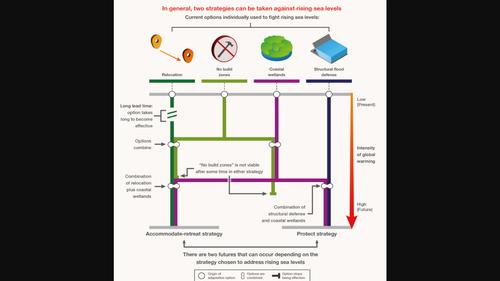当前位置:
X-MOL 学术
›
WIREs Clim. Chang.
›
论文详情
Our official English website, www.x-mol.net, welcomes your
feedback! (Note: you will need to create a separate account there.)
Adaptation pathways for effective responses to climate change risks
WIREs Climate Change ( IF 9.4 ) Pub Date : 2024-03-07 , DOI: 10.1002/wcc.883 Veruska Muccione 1, 2 , Marjolijn Haasnoot 3, 4 , Peter Alexander 5 , Birgit Bednar‐Friedl 6 , Robbert Biesbroek 7 , Elena Georgopoulou 8 , Gonéri Le Cozannet 9 , Daniela N. Schmidt 10
WIREs Climate Change ( IF 9.4 ) Pub Date : 2024-03-07 , DOI: 10.1002/wcc.883 Veruska Muccione 1, 2 , Marjolijn Haasnoot 3, 4 , Peter Alexander 5 , Birgit Bednar‐Friedl 6 , Robbert Biesbroek 7 , Elena Georgopoulou 8 , Gonéri Le Cozannet 9 , Daniela N. Schmidt 10
Affiliation

|
Climate related changes are already affecting every area of our world and will increasingly do so as global warming increases, resulting in compounding and cascading risks across multiple locations and sectors. Deliberative processes and anticipatory actions are required to adapt to the associated complex and uncertain systemic risks, with dynamic and long‐term planning needed even where there is limited knowledge of the effectiveness of adaptation. In this focus article, we examine the adaptation pathways developed for the Europe Chapter of the IPCC AR6. We argue that illustrative pathways built on quantitative and qualitative assessment of adaptation effectiveness can inform adaptation planning to manage the increasing severity of risks. We find that as the global warming level increases adaptation pathways can diverge, leading to radically different futures, for example, adaptation responses to sea level rise. We illustrate how adaptation measures for different risks interact resulting in trade‐offs, for example, increasing water scarcity. Although pathways offer a useful framework to address multiple adaptation challenges, other supporting conditions are needed for the successful implementation of adaptation, such as establishing legitimacy and buy‐in through collaboration of various actors and effective governance. Ultimately, adaptation will be increasingly more complex and constrained in a warmer world, increasing risks of losses and damages to people and nature.This article is categorized under: Vulnerability and Adaptation to Climate Change > Institutions for Adaptation The Social Status of Climate Change Knowledge > Climate Science and Decision Making Assessing Impacts of Climate Change > Evaluating Future Impacts of Climate Change Vulnerability and Adaptation to Climate Change > Learning from Cases and Analogies
中文翻译:

有效应对气候变化风险的适应途径
与气候相关的变化已经影响到世界的每个地区,并且随着全球变暖的加剧,影响将越来越大,导致多个地点和部门的复合和级联风险。需要采取审议过程和预期行动来适应相关的复杂和不确定的系统性风险,即使在对适应有效性的了解有限的情况下,也需要动态和长期的规划。在这篇焦点文章中,我们研究了为 IPCC AR6 欧洲分会制定的适应途径。我们认为,建立在适应有效性定量和定性评估基础上的说明性途径可以为适应规划提供信息,以管理日益严重的风险。我们发现,随着全球变暖程度的增加,适应途径可能会出现分歧,从而导致截然不同的未来,例如对海平面上升的适应反应。我们说明了针对不同风险的适应措施如何相互作用,从而导致权衡,例如加剧水资源短缺。尽管路径提供了一个有用的框架来应对多种适应挑战,但成功实施适应还需要其他支持条件,例如通过不同参与者的合作和有效治理来建立合法性和支持。最终,在气候变暖的世界中,适应将变得越来越复杂和受到限制,从而增加对人类和自然造成损失和损害的风险。本文分类如下: 气候变化的脆弱性和适应 > 适应机构 气候变化知识的社会现状 > 气候科学与决策 评估气候变化的影响 > 评估气候变化的未来影响 气候变化的脆弱性和适应 > 从案例和类比中学习
更新日期:2024-03-07
中文翻译:

有效应对气候变化风险的适应途径
与气候相关的变化已经影响到世界的每个地区,并且随着全球变暖的加剧,影响将越来越大,导致多个地点和部门的复合和级联风险。需要采取审议过程和预期行动来适应相关的复杂和不确定的系统性风险,即使在对适应有效性的了解有限的情况下,也需要动态和长期的规划。在这篇焦点文章中,我们研究了为 IPCC AR6 欧洲分会制定的适应途径。我们认为,建立在适应有效性定量和定性评估基础上的说明性途径可以为适应规划提供信息,以管理日益严重的风险。我们发现,随着全球变暖程度的增加,适应途径可能会出现分歧,从而导致截然不同的未来,例如对海平面上升的适应反应。我们说明了针对不同风险的适应措施如何相互作用,从而导致权衡,例如加剧水资源短缺。尽管路径提供了一个有用的框架来应对多种适应挑战,但成功实施适应还需要其他支持条件,例如通过不同参与者的合作和有效治理来建立合法性和支持。最终,在气候变暖的世界中,适应将变得越来越复杂和受到限制,从而增加对人类和自然造成损失和损害的风险。本文分类如下:






























 京公网安备 11010802027423号
京公网安备 11010802027423号